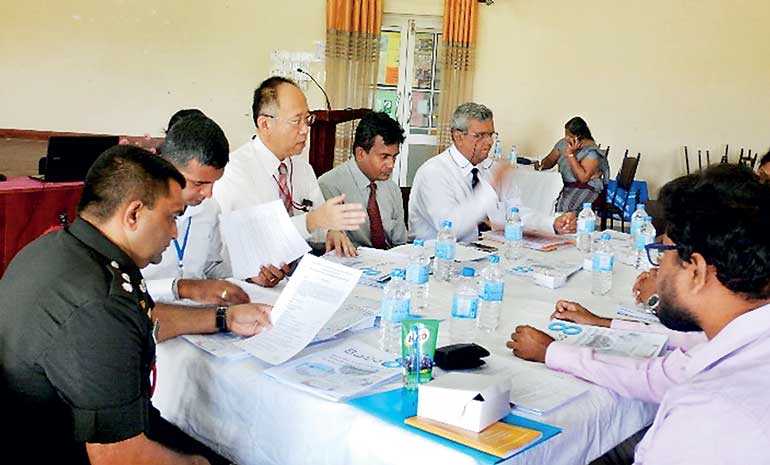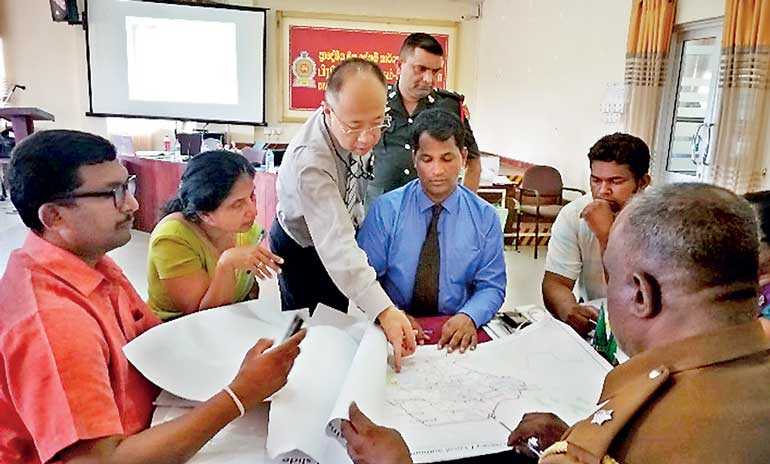Wednesday Apr 24, 2024
Wednesday Apr 24, 2024
Tuesday, 14 July 2020 00:00 - - {{hitsCtrl.values.hits}}

1st workshop for Local DRR Plan in Bulathsinhala

Drafting meeting for Local DRR Plan in Bulathsinhala

Field survey in resettlement site in Bulathsinhala with lecturers for the seminar

1st workshop for Local DRR Plan in Bulathsinhala

2nd workshop for Local DRR Plan in Ayagama

With the executive members of Disaster Management Division, Ministry of Defence
Japan International Cooperation Agency (JICA) has been cooperating with the Sri Lankan Government in the Disaster Management sector for a long time. In addition to various existing activities in the sector, JICA dispatched Takayuki NAGAI to the Ministry of Disaster Management (at that time) in 2017, as a Policy Advisor on Disaster Risk Reduction and he has completed his three years’ assignment in Sri Lanka on 23 June.
Nagai had provided policy advice on strengthening of Disaster Risk Reduction in the public administration based on his extensive experiences and expertise obtained in Japan.
His main outcomes are as follows:
Nagai contributed to drafting the revised National Disaster Management Plan (NDMP). As a result of his suggestion and recommendations, the concept of ‘Disaster Risk Reduction’ has been ‘more clearly’ reflected in the draft of revised NDMP which is in the finalisation process. His advice follows ‘Sendai Framework for Disaster Risk Reduction 2015-2030’ adopted at the Third World Conference on Disaster Risk Reduction in 2015, in which Japan led discussions. Sendai Framework mainly emphasises the importance of ‘Disaster Risk Reduction’.
1) The responsibility and demarcation of the relevant government organisations and the public in Disaster Risk Reduction are defined. Thereby, it is expected that the awareness on Disaster Risk Reduction of the respective organisations and public will be improved, which enhances commitments and participation of the public on Disaster Risk Reduction and their proactive evacuation when disaster occurs.
2)More emphasis is focused on the importance of preventive measures during this process. It is expected that the investments will be enhanced not only for post-disaster development but also on measures to prevent or mitigate damages caused by disaster before it occurs, such as constructions of embankments.
3)In addition to the ministries in-charge of disaster management, the importance of incorporating the disaster risk reduction by all the other government organisations in their development plans are clearly defined. It is expected that the necessary regulation and guidelines will be formulated for land use and development of residential zones with considering disaster risk especially due to flood and landslide. This will prevent to implement development activities where disaster risks exist.
Nagai also contributed to formulation of the ‘Local Disaster Risk Reduction Plan’, which is the first attempt by the Government of Sri Lanka, in selected two pilot areas. Local Disaster Risk Reduction Plan is developed by the local authorities and divisional secretariat divisions in collaboration with related organisations to plan and implement preventive measures. He had contributed to enhance the awareness of officers-in-charge of the pilot areas on importance of Disaster Risk Reduction in their development plans and facilitated to reflect the concept of Disaster Risk Reduction in the draft. In addition, he has drafted a guideline for officers of non-project areas based on accumulating know-hows and lessons learnt from the pilot areas.
Development of Local Disaster Risk Reduction Plan is set as a target in ‘Sendai Framework for Disaster Risk Reduction 2015-2030’, which Sri Lanka is supposed to follow, and Nagai’s contribution is a resource for further development of Local Disaster Risk Reduction Plan over Sri Lanka.
JICA will continuously work with the Government of Sri Lanka incorporating Nagai’s contributions for further promotion of Disaster Risk Reduction, and realising preventive investments to reduce disaster risks in the country.